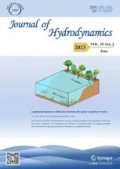Abstract
Cavitating flows are dominated by large gradients of physical properties and quantities containing complicated interfacial structures and lots of multi-scale eddies that need to be accurately characterized using a high-resolution mesh. The present work, within OpenFOAM, proposes an effective modeling framework using the large eddy simulation (LES) approach along with the volume of fluid (VOF) method to simulate the two-phase flow system and applies the Schnerr-Sauer model to calculate the mass-transfer rate between water and vapor. The adaptive mesh refinement (AMR) which is a powerful tool for allocating high-resolution grids only to the region of the greatest concern is adopted for improving the solution of interfacial structures. The effect of grid size is firstly investigated and the time-averaged quantities are verified against the experimental data, and then simulations of cavitating flows are successfully achieved to precisely characterize the features of cavitation with automatically and dynamically refining the mesh. As the refinement only takes place in the interfacial region, high-precision simulations can be achieved with limited computational resources, and the method shows promising prospects for modeling of the multi-scale, time-critical and computationally intensive cavitating flows.
Similar content being viewed by others
References
Wang G., Senocak I., Shyy W. et al. Dynamics of attached turbulent cavitating flows [J]. Progress in Aerospace Sciences, 2001, 37(6): 551–581.
Frikha S., Coutier-Delgosha O., Astolfi J. A. Influence of the cavitation model on the simulation of cloud cavitation on 2D foil section [J]. International Journal of Rotating Machinery, 2008, 1–12
Ji B., Luo X., Wu Y. et al. Numerical analysis of unsteady cavitating turbulent flow and shedding horse-shoe vortex structure around a twisted hydrofoil [J]. International Journal of Multiphase Flow, 2013, 51: 33–43.
Huang B., Zhao Y., Wang G. Large eddy simulation of turbulent vortex-cavitation interactions in transient sheet/cloud cavitating flows [J]. Computers and Fluids, 2014, 92(3): 113–124.
Yu A., Luo X. W., Ji B. et al. Cavitation simulation with consideration of the viscous effect at large liquid temperature variation [J]. Chinese Physics Letter, 2014, 31(8): 086401.
Lakshmipathy S., Girimaji S. S. Partially averaged Navier-Stokes (PANS) method for turbulence simulations: Flow past a circular cylinder [J]. Journal of Fluids Engineering, 2010, 132(12): 121202.
Ji B., Luo X., Arndt R. E. A. et al. Numerical simulation of three dimensional cavitation shedding dynamics with special emphasis on cavitation-vortex interaction [J]. Ocean Engineering, 2014, 87: 64–77.
Movahedian A., Pasandidehfard M., Roohi E. LES investigation of sheet-cloud cavitation around a 3-D twisted wing with a NACA 16012 hydrofoil [J]. Ocean Engineering, 2019, 192: 106547.
Chen G., Wang G., Hu C. et al. Combined experimental and computational investigation of cavitation evolution and excited pressure fluctuation in a convergent-divergent channel [J]. International Journal of Multiphase Flow, 2015, 72: 133–140.
Gnanaskandan A., Mahesh K. Large eddy simulation of the transition from sheet to cloud cavitation over a wedge [J]. International Journal of Multiphase Flow, 2016, 83: 86–102.
Roohi E., Pendar M. R., Rahimi A. Simulation of three-dimensional cavitation behind a disk using various turbulence and mass transfer models [J]. Applied Mathematical Modelling, 2016, 40: 542–564.
Li L., Li B., Hu Z. et al. Large eddy simulation of unsteady shedding behavior in cavitating flows with time-average validation [J]. Ocean Engineering, 2016, 125: 1–11.
Long X., Cheng H., Ji B. et al. Large eddy simulation and Euler-Lagrangian coupling investigation of the transient cavitating turbulent flow around a twisted hydrofoil [J]. International Journal of Multiphase Flow, 2017, 100: 41–56.
Li L., Li B., Liu Z. Modeling of gas-steel-slag three-phase flow in ladle metallurgy: Part II. Multi-scale mathematical model [J]. ISIJ International, 2017, 57(11): 1980–1889.
Luo X. W., Ji B., Tsujimoto Y. A review of cavitation in hydraulic machinery [J]. Journal of Hydrodynamics, 2016, 28(3): 335–358.
Popinet S. An accurate adaptive solver for surface-tension-driven interfacial flows [J]. Journal of Computational Physics, 2009, 228(16): 5838–5866.
Zheng X., Lowengrub J., Anderson A. et al. Adaptive unstructured volume remeshing — II: Application to two- and three-dimensional level-set simulations of multiphase flow [J]. Journal of Computational Physics, 2005, 208(2): 626–650.
Piggott M. D., Farrell P. E., Wilson C. R. et al. Anisotropic mesh adaptivity for multi-scale ocean modelling [J]. Philosophical Transactions of the Royal Society A, 2009, 367: 4591–4611.
Lee E., Ahn H. T. A reconstruction-based cell-centered high-order finite volume method for incompressible viscous flow simulation on unstructured meshes [J]. Computers and Fluids, 2018, 170: 187–196.
Tan H. An adaptive mesh refinement based flow simulation for free-surfaces in thermal inkjet technology [J]. International Journal of Multiphase Flow, 2016, 82: 1–16.
Schnerr G. H., Sauer J. Physical and numerical modeling of unsteady cavitation dynamics [C]. 4th International Conference on Multiphase Flow, New Orleans, USA, 2001.
Li L., Li B. Implementation and validation of a volume-of-fluid and discrete-element-method combined solver in OpenFOAM [J]. Particuology, 2018, 39: 109–115.
Mitchell W. F. A refinement-tree based partitioning method for dynamic load balancing with adaptively refined grids [J]. Journal of Parallel and Distributed Computing, 2007, 67(4): 417–429.
Charrière B., Decaix J., Goncalvès E. A comparative study of cavitation models in a Venturi flow [J]. European Journal of Mechanics — B/Fluids, 2015, 49: 287–297.
Rouse H., MsNown J. S. Cavitation and pressure distribution, head forms at zero angle of yaw [R]. Iowa, USA: State University of Iowa, 1948.
Acknowledgements
This work was supported by the Jiangsu Province Science Foundation for Youths (Grant No. BK20180505), the Fundamental Research Funds for the Central Universities (Grant No. 2019B14914)
Author information
Authors and Affiliations
Corresponding author
Additional information
Project supported by the China Postdoctoral Science Foundation (Grant No. 2018M630502).
Rights and permissions
About this article
Cite this article
Li, Lm., Hu, Dq., Liu, Yc. et al. Large eddy simulation of cavitating flows with dynamic adaptive mesh refinement using OpenFOAM. J Hydrodyn 32, 398–409 (2020). https://doi.org/10.1007/s42241-019-0041-1
Received:
Revised:
Accepted:
Published:
Issue Date:
DOI: https://doi.org/10.1007/s42241-019-0041-1




